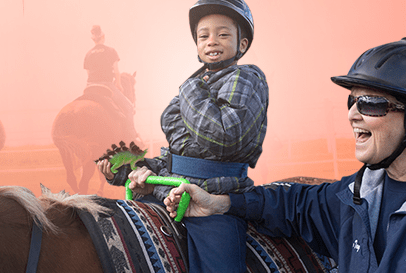Kids With CP Benefit From Therapeutic Horseback Riding

Horseback Riding Therapy for Kids With CP
Horseback riding is not just a fun activity, it can also be an effective form of physical therapy for people with cerebral palsy (CP). Therapeutic horseback riding is also known as equine therapy or hippotherapy.
While on a moving horse, a rider experiences rhythmic movement similar to the human gait. This can activate the part of the brain that controls movement, which can help the rider develop better balance and increased strength.
The Professional Association of Therapeutic Horsemanship International (PATH Intl) is an organization that certifies instructors and accredits organizations. There are hundreds of therapeutic horseback riding organizations around the country that are accredited by PATH Intl.
The Right Step in Colorado
One example of a therapeutic horse riding program is The Right Step, a nonprofit organization located in Littleton, Colorado. It is a PATH Intl Premier Center. The Right Step brings the joy and health benefits of horseback riding to people with disabilities. It also gives aging horses a meaningful job to do.
Benefits of Horseback Riding
Working with horses can have emotional and physical benefits. Directing a horse requires balance, good posture, and coordination. Children with cerebral palsy practice these skills and more when they’re horseback riding.
Horseback riding can help improve:
- Posture
- Muscle tone
- Gait patterns
- Flexibility
- Strength
- Balance
- Coordination
- Confidence
- Self-esteem
In a 2009 study, children with cerebral palsy were given 12 weeks of therapeutic horseback riding. Researchers observed a significant improvement in the children’s control of their head and trunk.
The emotional benefits of riding a horse come from many different factors. One factor is being able to accomplish a physical activity, which can boost a child’s confidence and self-esteem. Also, bonding with an animal can have positive effects on a child. Studies show that horses are incredibly perceptive, potentially giving them the ability to understand their rider’s needs.
How Equine Therapy Works
Generally, a new rider will be assisted by “side walkers” who walk alongside the horse to help the rider along the way as well as someone to lead the horse. Kids with cerebral palsy can sometimes progress from riding the horse with assistance to riding independently.
Another option for therapy is carriage driving instead of riding on the actual horse. In these cases, some people are able to direct a horse from their own wheel chair or from a custom chariot. Carriage driving is a great option for kids who are unable or uncomfortable about riding on a horse.
Find an Organization Near You
Since there are hundreds of organizations that use horses for therapy, you should be able to find one a reasonable distance from where you live. PATH Intl has a directory on their website or you could also do a simple online search for therapeutic horse riding near you.
As always, you should talk to your child’s doctor before starting a new type of therapy.
